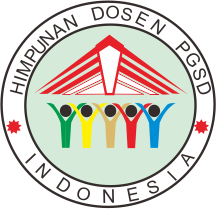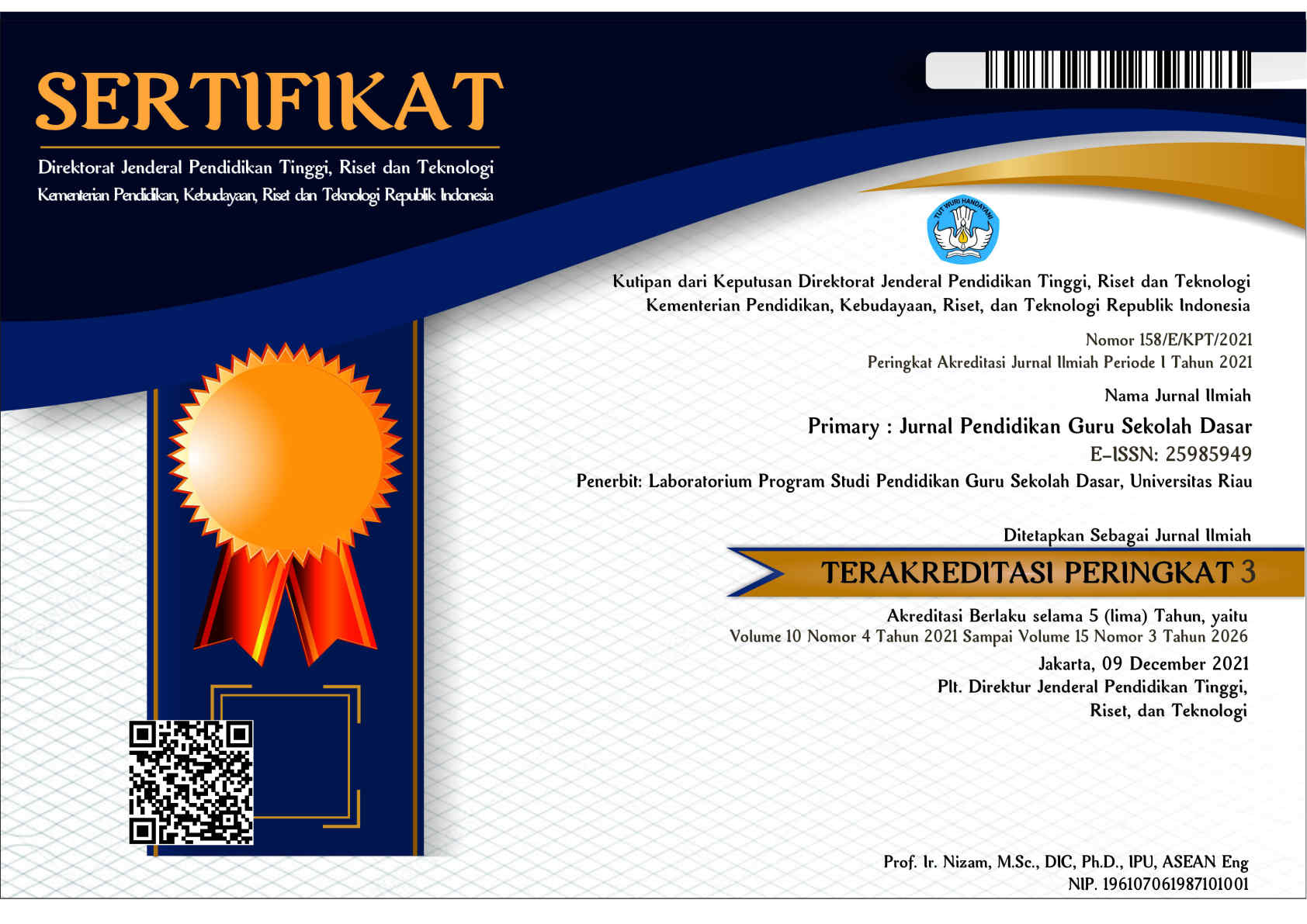TECHNOLOGY USE IN LEARNING TO READ: A LITERATURE REVIEW
Abstract
Learning to read in the 4.0 revolution era should be more focused on learning in the use of technology. Hence, the purpose of the research in this article was to analyze the learning process based on methods, analytical techniques, and findings in the terms of applying reading learning technology findings and analyzing the findings of publications on Google Scholar and Scopus. The type of research was literature research using a systematic review, which provided an overview of the publication of articles with the number of found data 56 articles. After conducting the review process, it was obtained that 25 articles matched the criteria. The research results showed that the most publications on the use of technology were in 2014, 2019, and 2021. Related to the place of publication, most publications used Scopus and Sinta 3 as many as 6 articles. The use of research was based on the research methods, which were mostly used on development methods at 48%. Thus, it could be seen from the results of the research that the use of technology in learning to read is able to improve reading skills.
Keywords
Full Text:
PDFReferences
Al-Ahdal, A. A. M. H. (2020). EBook interaction logs as a tool in predicting learner performance in reading. Asiatic, 14(1), 174–188. https://api.elsevier.com/content/abstract/scopus_id/85090691667.
Akyol, H. (2013). Türkçe Öğretim Yöntemleri [Turkish Teaching Methods]. Ankara: Pegem Akademy Publishing.
Arlinwibowo, J., Retnawati, H., & Kartowagiran, B. (2022). The impact of ICT utilization to improve the learning outcome: A meta-analysis. International Journal of Evaluation and Research in Education (IJERE), 11 (2), 522-531. DOI: 10.11591/ijere.v11i2.22112.
Ahmadi, F. (2010). Meningkatkan Minat Membaca Siswa Sekolah Dasar Dengan Metode Glenn Doman Berbasis Multimedia. Jurnal Penelitian Pendidikan, 27(1), 64-71.
Aminin, T., Setyadi, D., & Ricahyono, S. (2022). Penerapan E-Learning dalam Pembelajaran Membaca Bahasa Indonesia Kelas IV SDN Margomulyo 1 Ngawi Tahun Pelajaran 2021/2022. Wewarah: Jurnal Pendidikan Multidisipliner, 1(1), 18 – 23.
Aulia, F. M., Sudarma, M., & Suyadnya, I. M. A. (2018). Pemanfaatan Instant Messaging Untuk Aplikasi Pembelajaran Membaca Al-Qur’an Dengan Metode Tsaqifa. Sintech Journal, 1(2), 24-32.
Ali, J. T., & Patombongi, A. (2016). Perancangan Game Edukasi Pembelajaran Membaca Berbasis Android. Jurnal Sistem Informasi Dan Teknik Komputer Catur Sakti, 1(1), 1-8.
Annisa, W. (2017). Pembelajaran Membaca Pemahaman Dengan Metode Computer Assisted Language Learning (CALL) Melalui CD Interaktif Berorientasi Kearifan Lokal. Pakar Pendidikan, 15(1), 79-90.
Atikah, R., Prihatin, R. T., Hernayati, H., & Misbah, J. (2021). Pemanfaatan Google Classroom Sebagai Media Pembelajaran Di Masa Pandemi Covid-19. Jurnal Petik, 7(1), 7-18.
Amorim, A. N., Jeon, L., Abel, Y., Felisberto, E. F., Leopoldo, N. F., Barbosa, and Dias, N. M. (2019). Using Escribo Play Video Games to Improve Phonological Awareness, Early Reading, and Writing in Preschool. Educational Researcher, XX (X), 1–10.
DOI: 10.3102/0013189X20909824.
Başar, M. (2017). Effect of the SQ4R technique on the reading comprehension of elementary school 4th grade elementary school students. International Journal of Instruction, 10(2), 131–144. https://doi.org/10.12973/iji.2017.1029a.
Boakye, N.A.Y. (2021). Using role play and explicit strategy instruction to improve first-year students’ academic reading proficiency, Reading & Writing 12(1), a285. https://doi.org/10.4102/rw.v12i1.285.
Boakye, N.A.Y. & Linden, M-L. (2018). Extended strategy-use instruction to improve students’ reading proficiency in a content subject. Reading & Writing, 9(1). https://doi.org/10.4102/rw.v9i1.212.
Boakye, N.A.N.Y. & Mai, M.M. (2016). A needs analysis for a discipline-specific reading intervention. English Language Teaching 9(3), 235–247.
Boholano, H. (2017). Smart social networking: 21st Century teaching and learning skills, Research in Pedagogy, 7( 2), 21– 29. doi: 10.17810/2015.45.
Crijnen, A. A. M. (1998). The course and malleability of reading achievement in elementary school: The application of growth curve modeling in the evaluation of a mastery learning intervention. Learning and Individual Differences, 10(2), 137–157. https://doi.org/10.1016/S1041-6080(99)80138-1.
Dina, D. G., Vincenza, C., Tania, D. M., Rosita, C. M., Daniela, F., Rosella, G., & Pierpaolo, V. (2014). The silent reading supported by adaptive learning technology: Influence in the children outcomes. Computers in Human Behavior, xxx(xxx), 1-6. http://dx.doi.org/10.1016/j.chb.2014.09.053.
Endiawan, A.S., Fathurohman, I., & Santoso. (2020). The Development of Literacy Learning Media of Illustrated Story Based on Android E-Book toward Reading Interest of Third Grade Students. Primary: Jurnal Pendidikan Guru Sekolah Dasar, 9(4), 564-570. DOI:
http://dx.doi.org/10.33578/jpfkip.v9i4.7994.
Eldelena., Putra, M. J. A., & Syahrilfuddin. (2022). Development of Audio Visual Media Using Diorama Food Chain Materials for Class V Elementary School. EduTech: Education Technology Journal, 1(1), 24-32.
Fu, J. S. (2013). ICT in Education: A Critical Literature Review and Its Implications. International Journal of Education and Development using Information and Communication Technology, 9(1),112–125.
Faroqi, A., & Maula, B. (2014). Aplikasi Multimedia Interaktif Pembelajaran Membaca, Menulis, Berhitung (Calistung). Jurnal Inovasi Teknologi Pendidikan, VIII (2), 229-245.
Hautala, J. (2020). Identification of Reading Difficulties by a Digital Game-Based Assessment Technology. Journal of Educational Computing Research, 58(5), 1003–1028. https://doi.org/10.1177/0735633120905309.
Hasanudin, C. (2016). Pembelajaran Membaca Permulaan Dengan Menggunakan Media Aplikasi Bamboomedia Bmgames Apps Pintar Membaca Sebagai Upaya Pembentukan Karakter Siswa Sd Menghadapi MEA. Jurnal Pedagogia, 5(1), 1-12.
Isdiyanto, A., & Suyata, P. (2014). Pengembangan Media Pembelajaran Membaca Berbantuan Komputer Untuk Peserta Didik Kelas 1 Sekolah Dasar. Jurnal Inovasi Teknologi Pendidikan, 1 (2), 178-189.
Gae, N. A., Ganing, N. N., & Kristiantari, M. R. (2021). Pengembangan Media Video Animasi Berorientasi Membaca Pemahaman dengan Strategi Directed Reading Thinking Activity (DRTA) pada Muatan Bahasa Indonesia. Jurnal Penelitian dan Pengembangan Pendidikan, 5(1), 100-108.
Gaudreau, C., King, Y.A., Dore, R.A., Puttre, H., Nichols, D., Hirsh-Pasek, K., and Golinkoff, R.M. (2020). Preschoolers Benefit Equally From Video Chat, Pseudo-Contingent Video, and Live Book Reading: Implications for Storytime During the Coronavirus Pandemic and Beyond. Front. Psychol, 11, 2158. doi: 10.3389/fpsyg.2020.02158.
König, J., Jäger-Biela, D. J., and Glutsch, N. (2020).Adapting to online teaching during COVID-19 school closure: teacher education and teacher competence effects among early career teachers in Germany. European Journal of Teacher Education, 43(4), 608–622. doi: 10.1080/02619768.2020.1809650.
Kurniaman, O., & SB. Sismulyasih, N. (2019). The Influence of The Big Book Media Has The Character of Conservation in Early Reading. ELS Journal on Interdisciplinary Studies in Humanities, 2 (1), 141-147.
Kurniaman, O., Mulyani, E. A., Noviana, E., Sari, I. K., Permana, D.,
Irnanda, E., & Nanda, D. W. (2022). Development of Study Room Blog in Learning Reading Literacy in Elementary School. Al-Ishlah: Jurnal Pendidikan, 14 (2), 815-1826. DOI: 10.35445/alishlah.v14i1.1896.
Karaman, J., Setyanto, A., & Sofyan, A. F. (2018). Analisis Aplikasi Marbel Huruf Versi Mobile Terhadap Pembelajaran Membaca di Desa Semanding Ponorogo. Intensif: Jurnal Ilmiah Penelitian dan Penerapan Teknologi Sistem Informasi, 2(2), 98-106.
Lestari, P, M., & Putra, M, J, A. (2022).Implementation Of Science Learning Using Powtoon Media In Third Grade SDN002 Pulau Komang Sentajo. EduTech: Education Technology Journal, 1(1), 7-12.
Małgorzata. O., & Krystyna, B. (2020). Education and Digital Competencies of Elder Adults. Kultura—Społeczeństwo—Edukacja. 165–185.
Marsigit, M., et al. (2020). Constructing Mathematical Concepts through External Representations Utilizing Technology: An Implementation in IRT Course. TEM Journal, 9(1),317–326. doi: 10.18421/TEM91.
Maulidina, M. A., Susilaningsih, S., & Abidin, Z. (2018). Pengembangan Game Based Learning Berbasis Pendekatan Saintifik Pada Siswa Kelas Iv Sekolah Dasar. JINOTEP, 4(2), 113-118.
M. Dixon-Woods, “Systematic reviews and qualitative methods,” in Qualitative research: theory, method and practice, 3rd ed.,D. Silverman, Ed. London: Sage, 2011.
Marlini, C., & Rismawati, R. (2019). Praktikalitas Penggunaan Media Pembelajaran Membaca Permulaan Berbasis Macromedia Flash. Jurnal Tunas Bangsa, 6(2), 277-289.
Muftianti, A & Setiyadi, R. (2019). Penyusunan bahan ajar interaktif berbasis teknologi informasi untuk meningkatkan kemampuan mengajar keterampilan berbahasa siswa sekolah dasar. Jurnal P2M STKIP Siliwangi, 6 (2), 178-186.
Mize, M., Park, Y., Schramm-Possinger, M., and Coleman, M. B. (2019). Developing a Rubric for Evaluating Reading Applications for Learners With Reading Difficulties. Intervention in School and Clinic, 1–9.
Putrislia, N. A., & Airlanda, G. S. (2021). Pengembangan E-Book Cerita Bergambar Proses Terjadinya Hujan untuk Meningkatkan Minat Membaca Siswa di Sekolah Dasar. Jurnal Basicedu, 5 (4), 2036 – 2044.
Pradina, N. P. (2022). Development of Audio-Visual Media In Listening Learning For Grade IV Elementary School Students. EduTech: Education Technology Journal, 1(1), 13-23.
Retnawati, H., et al. (2017). Implementing the computer-based national examination in Indonesian School: The challenges and strategies. Problems of Education in The 21st Century, 75(6), 612–633.
Sefriani,R., Sepriana, R., Wijaya, I., Radyuli, P., and Menrisal, M. (2021). Blended learning with Edmodo: The effectiveness of statistical learning during the COVID-19 pandemic. International Journal of Evaluation and Research in Education (IJERE), 10( 1), 293. doi: 10.11591/ijere.v10i1.20826.
Saat, F., & Özenç, E. G. (2022). Effect of Self-Evaluation-Based Oral Reading Method in Elementary School on Reading Fluency and Reading Comprehension. Participatory Educational Research (PER), 9(2), 437-462. http://dx.doi.org/10.17275/per.22.48.9.2.
Sholeh,M., Murtono, M., & Masfuah, S. (2021). Efektivitas Pembelajaran Google Classroom Dalam Meningkatkan Kemampuan Literasi Membaca Siswa. 7(1), 134-140. DOI: 10.31949/educatio.v7i1.889.
Sugiyani, Y., Rosalina, V., & Yunan, I. (2014). Perancangan Aplikasi Edukatif Berbasis Multimedia Untuk Memudahkan Siswa Belajar Membaca Pada Mata Pelajaran Bahasa Indonesia. Jurnal PROSISKO, 1(1), 55-59.
Sabatini, J., O’Reilly, T., Weeks, J., & Wang, Z. (2019). Engineering a Twenty-First Century Reading Comprehension Assessment System Utilizing Scenario-Based Assessment Techniques. International Journal of Testing, 1-23. DOI: 10.1080/15305058.2018.1551224.
Saefudin, A., Munjiatun, M. (2022).Analisis of Gadget Utilization in Learning at SDN 09 Buatan Baru. EduTech: EducationTechnologyJournal, 1(1), 1-6.
Syofriend, Y. (2014). Early Childhood Reading Learning Based on Information
Technology. Indonesian Journal Of Early Childhood Education Studies, 3(1), 18-30. doi:10.15294/ijeces.v3i1.9471.
Wamesea, G., Notanubun, Z., & Abdurachman, O. Penggunaan Zoom Meeting Sebagai Sarana Pembelajaran Dalam Meningkatkan Keterampilan Membaca Intensif. Sistem-Among : Jurnal Pendidikan Sekolah Dasar, 1(6), 1-7. Retrieved from https://journal.actual-insight.com/index.php/sistem-mong/article/view/484.
DOI: http://dx.doi.org/10.33578/jpfkip.v11i5.9047
Refbacks
- There are currently no refbacks.
Copyright (c) 2022 Otang Kurniaman, L.N. Firdaus, Hadriana Hadriana, Sumarno Sumarno

This work is licensed under a Creative Commons Attribution-NonCommercial-ShareAlike 4.0 International License.
____________________________________________________________
Primary: Jurnal Pendidikan Guru Sekolah Dasar
Secretariat
Program Studi Pendidikan Guru Sekolah Dasar
Gedung B1, FKIP Universitas Riau
Kampus Bina Widya Km. 12,5 Simpang Baru Panam
Pekanbaru Riau Indonesia 28293
e-mail : primary@ejournal.unri.ac.id



